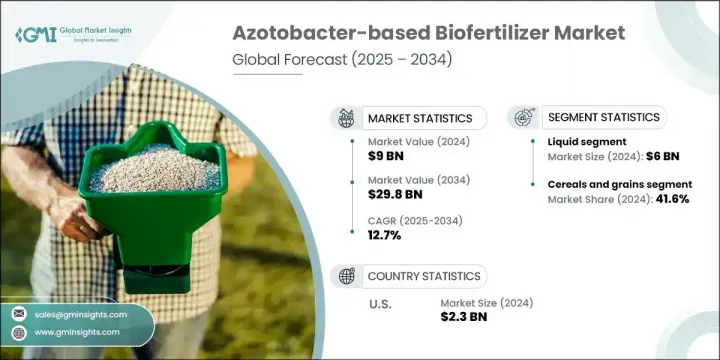
세계의 아조토박터 기반 바이오 비료 시장은 2024년에 90억 달러로 평가되었고, CAGR 12.7%로 성장하여 2034년에는 298억 달러에 이를 것으로 추정되고 있습니다.
이 급성장의 배경은 세계 인구 증가, 지속가능한 농업에 대한 관심 증가와 유기농법으로의 전환을 포함합니다. 화학합성비료의 유해성에 대한 우려가 높아짐에 따라 농가들은 보다 환경친화적인 대체품으로의 전환을 꾸준히 진행하고 있습니다. 화학 비료를 사용하지 않는 농산물을 요구하는 소비자의 목소리는 바이오 비료로의 전환을 더욱 뒷받침하고 있습니다. 정부는 또한 장려금 기반 프로그램을 통해 지속가능한 관행의 촉진에 나서고 있으며, 바이오비료업계에 기세를 기울이고 있습니다. 아조토박터 기반 제품은 대기 중의 질소를 자연스럽게 고정하고 토양의 질을 향상시키고 식물의 발달을 지원합니다.

아조토박터 기반 바이오 비료는 환경 변동으로 인한 성능의 일관성 문제에 직면하고 있습니다. 토양의 pH, 온도, 함수율 등의 요인이 결과에 영향을 주기 때문에 지역에 따라 결과가 변동하면 농가는 낙담할지도 모릅니다. 보존 기간이 제한되어 있는 것도 장애물 중 하나이며 제품의 유효성이 손실되면 사용자 경험이 저하되고 지역에 따라 채택이 억제되어 보급이 지연될 수 있습니다.
| 시장 범위 | |
|---|---|
| 시작 연도 | 2024년 |
| 예측 연도 | 2025-2034년 |
| 시작금액 | 90억 달러 |
| 예측 금액 | 298억 달러 |
| CAGR | 12.7% |
액상 제형 부문은 2024년에 60억 달러의 매출을 올렸으며, 그 적용 효율, 균일한 적용 범위, 취급의 용이함에 의해 주도적 지위를 차지하고 있습니다. 이러한 특성은 특히 대규모 농업에 적합한 선택입니다. 농업용 살포 시스템과의 호환성이 여러 농업 환경에서 널리 사용되고 있음을 뒷받침합니다.
곡물 및 곡류는 2024년에 41.6%의 점유율을 차지했으며, 작물 유형별로 최대의 점유율을 유지하고 있습니다. 이러한 이점은 식량안보에 대한 세계 수요 증가, 정부가 지원하는 유기농업에 대한 노력, 곡류 및 곡물작물의 수율을 향상시키는 아조토박터 기반 바이오비료의 입증된 능력에 의해 뒷받침됩니다. 토양의 건전성에 대한 의식이 높아지는 가운데 많은 농가들이 생산성을 유지하면서 지속가능성의 목표를 달성하기 위해 이러한 바이오비료를 채택하고 있습니다.
미국 아조토박터 기반 바이오 비료 2024년 시장 규모는 23억 달러로 현대적인 농업 기술, 유기농업에 대한 강력한 추진, 확립된 농업 부문이 원동력이 되고 있습니다. 지지적인 규제 프레임워크과 토양 보전에 관한 의식의 고조가 계속해서 국가 전체의 도입율을 끌어 올리고 있습니다. 캐나다에서는 환경 친화적인 관행에 대한 신봉이 증가하고 지속 가능한 농업이 중요해지면서 시장이 급성장하고 있습니다. 연구기관과 주요 기업의 협력으로 새로운 효율적인 제품 변형이 생겨 아조토박터 기반 솔루션의 사용 범위가 넓어지고 있습니다.
아조토박터 기반 바이오 비료 시장의 주요 진출기업으로는 Growtech Agri Science, Biotech International, KN BIO SCIENCES, Unisun Agro, IFFCO, Rizobacter, FARMADIL INDIA LLP, Green Vision Life Sciences, Gujarat State Fertilizers &Chemicals,Jaipur Bio Fertilizers.등 입니다. 세계의 아조토박터 기반 바이오 비료 시장에 진출한 기업들은 제품 혁신, 목표를 겨냥한 제휴, 배합의 다양화에 주력함으로써 시장의 존재를 확대하고 있습니다. 대기업은 R&D에 투자하고 다양한 토양 및 기후 조건에 적합한 안정적이고 오래 지속되는 바이오 비료를 개발하고 있습니다. 연구 기관 및 대학과의 전략적 파트너십은 제품 성능과 지역 적응성을 높입니다. 일부 기업은 다양한 작물에 대한 맞춤형 솔루션을 중시하고, 충분한 서비스를 받지 못한 농업 지역에 도달하기 위해 유통망을 확대하고 있습니다.
The Global Azotobacter-based Biofertilizer Market was valued at USD 9 billion in 2024 and is estimated to grow at a CAGR of 12.7% to reach USD 29.8 billion by 2034. This rapid growth is being driven by the rising global population, increasing focus on sustainable farming, and a shift toward organic agricultural practices. As concerns around the harmful effects of synthetic fertilizers grow, farmers are steadily moving toward more eco-friendly alternatives. Consumers' demand for chemical-free produce is further encouraging the switch to biofertilizers. Governments are also stepping in to promote sustainable practices through incentive-based programs, creating momentum in the biofertilizer industry. Azotobacter-based products are particularly gaining traction as they naturally fix atmospheric nitrogen, enrich soil quality, and support plant development-all while minimizing the environmental burden and offering a cost-effective solution compared to conventional options.

Azotobacter-based biofertilizers face challenges around consistency in performance due to environmental variability. Factors such as soil pH, temperature, and moisture content influence outcomes and may discourage farmers when results fluctuate across different regions. Limited shelf life is another hurdle, as any loss in product efficacy can lead to poor user experience and restrained adoption in some areas, potentially slowing down widespread use.
| Market Scope | |
|---|---|
| Start Year | 2024 |
| Forecast Year | 2025-2034 |
| Start Value | $9 Billion |
| Forecast Value | $29.8 Billion |
| CAGR | 12.7% |
The liquid formulations segment generated USD 6 billion in 2024, holding a leading position due to their application efficiency, uniform coverage, and ease of handling. These attributes make them a preferred option, particularly for large-scale farming operations. Their compatibility with agricultural application systems further supports their widespread use across multiple farming environments.
The cereals and grains accounted for 41.6% share in 2024, maintaining the largest share by crop type. This dominance is supported by rising global demand for food security, government-backed organic farming initiatives, and the proven ability of azotobacter-based biofertilizers to improve grain and cereal crop yields. With growing awareness around soil health, many farmers are adopting these biofertilizers to meet sustainability goals while maintaining productivity.
U.S. Azotobacter-based Biofertilizer Market was valued at USD 2.3 billion in 2024, driven by modern agricultural techniques, a strong push toward organic farming, and a well-established farming sector. Supportive regulatory frameworks and heightened awareness around soil conservation continue to boost adoption rates across the country. In Canada, the market is growing rapidly with increasing adherence to environmentally responsible practices and an emphasis on sustainable agriculture. Collaboration between research organizations and key players is helping bring out new, efficient product variants and expanding the usage scope of azotobacter-based solutions.
Key participants in the Azotobacter-based Biofertilizer Market include Growtech Agri Science, Biotech International, K. N. BIO SCIENCES, Unisun Agro, IFFCO, Rizobacter, FARMADIL INDIA LLP, Green Vision Life Sciences, Gujarat State Fertilizers & Chemicals, and Jaipur Bio Fertilizers. Companies in the global azotobacter-based biofertilizer market are expanding their market presence by focusing on product innovation, targeted collaborations, and diversification of formulations. Leading players are investing in R&D to develop stable, long-lasting biofertilizers suitable for diverse soil and climate conditions. Strategic partnerships with research institutions and universities enhance product performance and regional adaptability. Several firms are emphasizing tailored solutions for different crops and expanding their distribution networks to reach under-served agricultural regions.